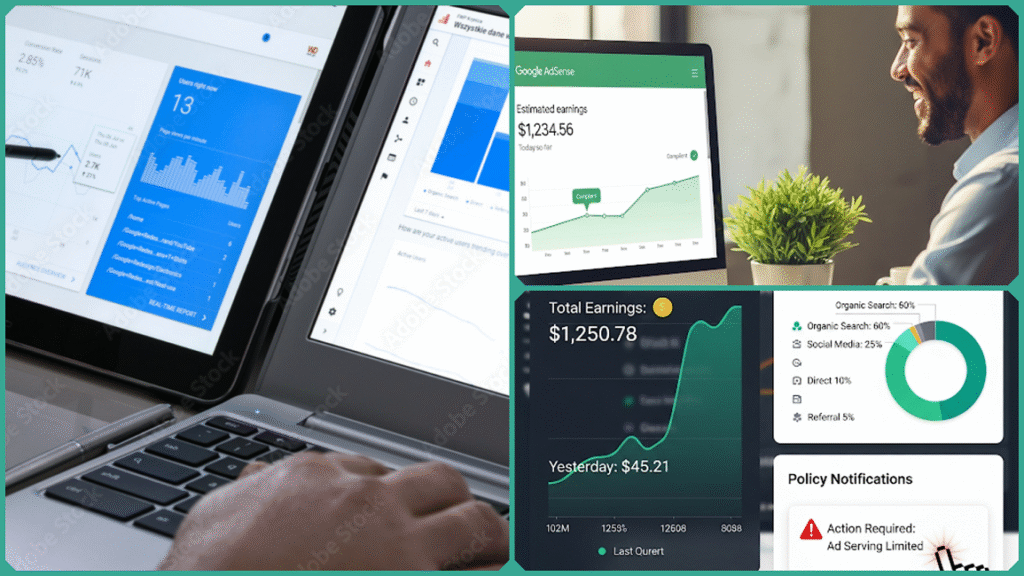Best Google Policy Guide for Sustainable AdSense Arbitrage
Estimated reading time: 24 minutes
Google AdSense arbitrage is a highly strategic business model in which publishers acquire website traffic at a relatively low cost and then monetize this traffic by displaying Google AdSense advertisements to generate profit. This method, although potentially very lucrative and profitable, demands a thorough understanding of the Google policy to ensure full compliance.
Adhering to these guidelines is essential for maintaining a sustainable, long-term revenue system that can continuously deliver consistent earnings over time. Experienced AdSense publishers, entrepreneurs, online marketing students, and even those looking for a “silver bullet” solution can benefit immensely from the definitive best Google policy guide that follows.

This comprehensive guide is designed to help you effectively avoid costly penalties, prevent account suspensions, and minimize any potential revenue loss by thoroughly mastering the essential strategies needed to comply fully with the Google policy. At the same time, it enables you to maximize the lucrative arbitrage opportunity, ensuring you optimize your outcomes while staying within all regulatory guidelines.
Key Concepts and Theories of Google AdSense Arbitrage
Google AdSense arbitrage functions as a complex and strategic business model that intricately combines the processes of acquiring targeted traffic, effectively monetizing that traffic through well-placed advertisements, and implementing a thoughtful content strategy.
Gaining a deep understanding of these fundamental pillars is absolutely essential for any publisher who aspires to develop and maintain a long-lasting and profitable arbitrage system in the competitive digital landscape.
Traffic Acquisition
This concept forms the very foundation of arbitrage, a strategy where publishers actively seek out and purchase inexpensive traffic from a wide variety of different sources. Their main goal is to attract visitors to their website at a cost that is significantly lower than the amount of revenue generated from each visitor.
By carefully managing this balance, they aim to maximize their profits. Some of the most popular and commonly used traffic sources in this process include:
- Paid search advertisements, including popular platforms like Google Ads and Bing Ads, focus on targeting specific keywords that exhibit a high level of intent from users actively searching for relevant products or services. These ads are designed to appear prominently in search engine results, capturing the attention of potential customers who have already expressed interest through their search queries, thereby increasing the likelihood of clicks and conversions.
- Social media advertising on popular platforms such as Facebook and Instagram offers highly customizable targeting options, allowing advertisers to precisely reach audiences based on a wide range of demographics and specific interests. This detailed targeting capability enables businesses to tailor their marketing campaigns to the exact preferences, behaviors, and characteristics of their ideal customers, greatly enhancing the effectiveness and efficiency of their advertising efforts.
- Native advertising networks such as Taboola and Outbrain specialize in seamlessly integrating sponsored content within editorial streams, creating a natural and unobtrusive user experience. These platforms are designed to blend promotional material with regular editorial content, making advertisements appear as a part of the overall content flow rather than as separate or disruptive ads. By doing so, they effectively capture the audience’s attention while maintaining the aesthetic and editorial integrity of the host site. This approach helps advertisers reach their target audience more efficiently by placing relevant sponsored content directly where users are already engaged.
- Pop-up and pop-under ads, while effective in certain advertising strategies, carry a significantly higher risk if they are not carefully managed and implemented with consideration for the user experience. These types of ads can often be intrusive and disruptive, potentially leading to negative perceptions of the brand if users find them annoying or invasive. Therefore, it is crucial to balance their use with thoughtful placement and timing to ensure they do not detract from the overall user experience on the website.
The primary objective in this context is to guarantee that the quality of traffic is authentic and fully compliant with all Google policies. It is essential to avoid any form of artificial traffic, such as bots or incentivized clicks, as these can result in serious penalties or account suspensions. Ensuring the traffic is genuine helps maintain the integrity of the advertising campaigns and promotes sustainable performance over time.
AdSense Monetization
Once visitors start arriving on the website, the primary objective becomes to effectively monetize this incoming traffic by utilizing Google AdSense advertisements. Website publishers can generate revenue through several methods, including:
- Cost Per Click (CPC) is a revenue model where earnings are generated every single time a visitor clicks on an advertisement. This means that each individual click on the ad directly contributes to the overall revenue, making it a performance-based advertising strategy that rewards engagement and user interaction.
- Cost Per Mille (CPM) is a pricing model where the revenue generated is based on the number of impressions, meaning the number of times an ad is displayed to users. This model is typically used for websites with high traffic volumes, as it allows advertisers to reach a large audience effectively, while publishers can monetize their site traffic efficiently. CPM is calculated per thousand impressions, making it a popular choice for sites aiming to maximize ad revenue through extensive visitor exposure.
Maximizing revenue effectively relies heavily on implementing strategic ad placement, choosing relevant and engaging ad formats, and carefully selecting niches that have a high cost-per-click (CPC) potential.
These factors work together to ensure that the earnings generated from advertisements consistently exceed the overall traffic acquisition costs, which is essential for maintaining long-term profitability and sustainable growth in revenue.
Content Strategy and Optimization
Content is the primary engine that drives user engagement and significantly boosts ad interaction across platforms. To achieve effective arbitrage, it is essential to focus on several key elements:
- Creating or carefully curating original, high-quality content that not only attracts visitors but also engages and retains them over time is essential for building a successful online presence. This involves producing valuable and relevant material that resonates with the target audience and encourages them to return frequently.
- Incorporating proven SEO best practices is essential to effectively drive a steady flow of organic traffic to your website while simultaneously enhancing the performance of your paid traffic campaigns. By strategically optimizing your content and site structure, you can maximize visibility in search engine results, attract more qualified visitors, and create a cohesive marketing approach that supports both organic growth and paid advertising efforts.
- Ongoing and continuous optimization of both website content and overall layout is essential to significantly enhance the user experience while also ensuring full compliance with Google’s ever-evolving and detailed content policies. This process involves regularly updating text, images, and design elements in order to create a seamless, engaging, and user-friendly environment that meets the highest standards set by search engines and user expectations alike.
- Carefully testing and continuously refining various ad placements and types is essential for maximizing revenue potential, all while ensuring that user trust remains intact and the overall integrity of the site is preserved. This balanced approach allows for optimized earnings without compromising the user experience or the credibility of the website.
Sustainability emerges when a publisher develops a compliant funnel where the income from Google AdSense consistently surpasses the outlay on traffic acquisition. Achieving this balance demands strict adherence to Google’s content and ad policies, genuine traffic sources, and ongoing data-driven optimization to prevent any policy violations or risk of account suspension.
This foundational understanding thoroughly equips publishers with the essential knowledge and skills needed to effectively navigate the many complexities and abundant opportunities presented by Google AdSense arbitrage, thereby setting a solid and reliable stage for achieving sustainable, long-term, and fully compliant monetization growth in their online ventures.
Current Trends and Developments in AdSense Arbitrage and Google Policies
In recent years, particularly throughout 2024 and continuing into 2025, Google has introduced a series of significant and impactful updates to the AdSense program aimed at modernizing monetization strategies and strengthening policy enforcement for publishers involved in arbitrage activities.
Gaining a thorough understanding of these ongoing trends and regulatory developments is absolutely essential for anyone looking to maintain a compliant, sustainable, and profitable AdSense arbitrage operation in today’s rapidly evolving digital advertising landscape.
Revenue Share Update and Transition to CPM Model
One of the most significant changes Google enacted in early 2024 is a shift from a pay-per-click (CPC) revenue model to a pay-per-impression (CPM) model. Rather than earning solely when users click ads, publishers are now compensated for every 1,000 ad impressions served on their site.
Alongside this, Google revised its AdSense revenue share structure. Previously, publishers generally received about 68% of ad revenue under a single transaction process. Now, revenue sharing is split distinctly into buy-side (advertiser payment platform) and sell-side (AdSense publisher) portions.
- For advertisements that are bought directly through Google Ads, Google typically takes around a 15% cut from the total amount the advertiser spends. After this deduction, publishers receive approximately 80% of what remains from that original advertising budget.
- For third-party advertising platforms, the publisher typically earns approximately 80% of the net revenue that is passed along from the buy-side platform after all fees and expenses are deducted. This means the publisher receives a significant majority share of the revenue generated through these external ad platforms, ensuring a substantial portion of the earnings flows back to the publisher from the total amount paid by advertisers.
Despite the significant structural changes implemented, Google’s extensive testing and analysis indicate that publisher earnings are expected to remain largely stable without major fluctuations. This new model offers publishers much clearer revenue transparency, allowing them to better understand their income sources.
Additionally, it offers a consistent and standardized foundation for comparison across a wide range of monetization platforms, which significantly simplifies the process for publishers when it comes to evaluating and optimizing their revenue strategies effectively and efficiently.
Traffic Quality and Compliance Focus
Google continues to strongly emphasize the critical importance of generating legitimate, high-quality traffic for arbitrage publishers. The use of bots, click farms, incentivized traffic, or any other non-human sources is strictly prohibited under Google’s policies and can result in severe consequences such as immediate account suspension or the imposition of ad serving limitations.
Therefore, publishers are required to rigorously monitor, carefully analyze, and thoroughly vet all of their traffic sources on an ongoing basis to ensure full compliance with Google’s stringent and detailed traffic policies at all times without exception.
Elevated Content Quality and Originality Standards
Google’s policies now strictly mandate that arbitrage sites must feature uniquely valuable and original content that truly stands out. Content that is scraped from other sources, automatically generated without careful human input, or spun with little to no meaningful editorial oversight is strongly discouraged and can lead to serious policy violations.
Publishers are encouraged to focus on creating deep, engaging, and genuinely original articles that thoroughly satisfy user intent while also meeting and exceeding Google’s high-quality standards and thresholds.
Ad Placement Limits to Protect User Experience
Google recommends that publishers limit the number of ads displayed on each page to typically between three and five to maintain a healthy balance between effective monetization and a positive user experience.
Overloading web pages with an excessive number of ads or deceptively placing ads—such as positioning them too close to clickable content or interactive elements—can result in policy violations being triggered or a significant reduction in user trust and satisfaction.
Maintaining this delicate balance helps ensure that visitors remain consistently engaged and interested, while at the same time allowing publishers to generate revenue effectively without compromising or diminishing the overall quality and user experience of the site.
Mobile Optimization and Site Performance
With mobile traffic continuing to dominate the online landscape more than ever before, Google now requires websites to be fully optimized for mobile devices, ensuring they are completely mobile-friendly and feature fast load times.
The speed at which pages load and the overall mobile usability of a site are directly connected to Google’s ranking algorithms, as well as strict adherence to AdSense policies. This makes thorough technical optimization not just beneficial but essential for maintaining sustainable and successful arbitrage operations in the long term.
Transparency through Essential Site Pages
Publishers are required to maintain full transparency by including several essential pages, such as About, Contact, Privacy Policy, and Terms of Service, on their websites. These important pages not only enhance the overall credibility and trustworthiness of the site but also ensure compliance with Google’s strict trust and safety guidelines.
Strictly adhering to these guidelines is an absolutely critical and essential factor not only in successfully gaining approval for AdSense but also in guaranteeing the continued smooth and uninterrupted operation of the advertising service on the platform over the long term.
By thoughtfully integrating these current, evolving trends into their existing arbitrage workflows, publishers have the opportunity to build sustainable, long-term, and policy-compliant AdSense revenue streams that effectively minimize risk while simultaneously maximizing their overall earning potential and profitability.
This thorough understanding of the latest policy shifts and emerging market trends serves as an indispensable and valuable asset for any serious and dedicated AdSense arbitrage publisher who is navigating the constantly evolving and rapidly changing digital advertising landscape.
Best Practices for a Sustainable AdSense Arbitrage Strategy
AdSense arbitrage has long been a high-risk game, notorious for its short shelf life and the constant threat of a Google policy violation. The traditional model of simply buying low-cost traffic for a quick profit is fundamentally unsustainable in today’s ecosystem.
This guide will walk you through the best practices for building a truly sustainable AdSense arbitrage strategy—one that prioritizes compliance and user value to create a reliable, long-term business in harmony with Google’s policies.
Secure Google AdSense Approval with Quality Content and Site Structure
- Choose a High-Value Niche: Select niches that are known for having competitive Cost Per Click (CPC) rates, such as finance, insurance, technology, or legal services. These particular sectors tend to attract advertisers who are willing to pay significantly higher amounts, which can substantially improve the overall profitability of your arbitrage efforts. By focusing on these high-value niches, you increase the chances of generating better revenue and achieving more successful outcomes in your campaigns.
- Build a Professional, Mobile-Friendly Website: Use trusted and widely recognized content management platforms such as WordPress to develop a well-organized, visually appealing, and user-friendly website. Ensuring your site is mobile responsive is essential, especially considering Google’s strong emphasis on mobile usability when it comes to search engine ranking and overall compliance with modern web standards. This approach helps guarantee a seamless experience for visitors across all devices, improving engagement and boosting your site’s visibility.
- Create 15–20 Unique, Informative Articles: Publish original and well-researched content that consistently delivers substantial value, effectively addresses user intent, and is carefully optimized for SEO with relevant keywords thoughtfully and strategically placed throughout the text. Producing this volume of high-quality content establishes a strong foundation to attract, engage, and retain visitors while also meeting and exceeding Google’s quality guidelines and ranking criteria. This approach not only enhances visibility but also builds authority and trust with your target audience over time.
- Add Essential Transparency Pages: It is crucial to include key pages such as About, Contact, Privacy Policy, and Terms of Service on your website. These pages help build trust with your visitors by providing important information about your business and how you operate. Additionally, having these pages fulfills Google’s requirements for site transparency, which can improve your website’s credibility and search engine ranking. Including detailed and clear content on these pages ensures that users feel confident and secure when interacting with your site.
- Implement Monitoring Tools: From the very beginning of your project, it is essential to integrate powerful monitoring tools such as Google Analytics, Google Search Console, and other relevant tracking systems. These tools will allow you to comprehensively monitor website traffic, analyze user behavior patterns in detail, and quickly identify any potential technical or performance issues that may arise. By setting up these monitoring solutions early on, you ensure continuous oversight and valuable insights that can guide your ongoing optimization efforts effectively.
Traffic Acquisition – Use Legitimate and Diverse Sources
- Focus on Legitimate Paid Traffic: Invest primarily in well-structured Google Ads campaigns that specifically target high-intent keywords closely related to your niche or industry. Utilize advanced geographic and demographic targeting features to ensure your ads reach the most relevant and engaged audience segments. This strategic approach helps maximize the effectiveness and return on investment of your advertising budget.
- Avoid Risky Traffic Sources: It is essential to steer clear of bots, click farms, incentivized traffic, and any other forms of non-human traffic. These types of traffic sources are strictly prohibited by Google and can result in severe consequences such as account suspensions or permanent bans. Ensuring that your traffic comes from genuine human visitors helps maintain the integrity of your site and protects your online presence from being penalized.
- Use Advanced Tracking: Employ UTM parameters, detailed conversion tracking, and comprehensive analytics tools to accurately identify and analyze high-performing traffic segments. By gaining deeper insights into which sources drive the most valuable traffic, you can continuously optimize your marketing campaigns. This includes strategically reallocating your budget to focus more on the better-performing traffic sources, while pausing or reducing spend on low-quality or underperforming traffic to maximize overall campaign effectiveness and return on investment.
Ad Placement Strategy Aligned with Google Policy
- Ad Volume: To maintain a good balance between user experience and effective monetization, it is recommended to limit the number of AdSense ad placements to a range of three to five ads per page. This approach helps ensure that the page remains user-friendly while still generating revenue.
- Ad Positioning: Place advertisements thoughtfully within various sections of your website, such as content areas, sidebars, and footers, ensuring they are visible to users while maintaining a non-intrusive presence. It is important to avoid positioning ads too close to clickable elements or interactive buttons to prevent any accidental clicks and to maintain a positive user experience. Proper ad placement helps balance visibility and usability, making sure the ads attract attention without disrupting the natural flow of the content.
- Ad Formats: Experiment with a variety of different AdSense ad formats, including text-based ads, eye-catching display banners, and seamlessly integrated native ads. By exploring these diverse options, you can identify the best combinations that maximize your revenue potential while ensuring full compliance with all relevant policies and guidelines.
- User Experience Priority: Maintain a site design that consistently prioritizes easy and intuitive navigation, ensuring users can find what they need quickly and effortlessly. Focus on minimizing distractions throughout the site to create a clean, streamlined browsing experience. This approach significantly enhances user engagement by keeping visitors focused and interested, while also effectively reducing the bounce rate as users are encouraged to explore more pages and spend additional time on the site.
Constant Monitoring and Optimization
- Audit Traffic Quality Regularly: Make it a consistent practice to use tools like Google Analytics and Google Search Console to carefully monitor and analyze your website traffic. By regularly checking these platforms, you can identify any unusual spikes or sudden drops in traffic that may suggest potential compliance problems or issues with your site’s performance. This ongoing review helps ensure that your traffic remains genuine and aligns with your quality standards.
- Study User Behaviour: Carefully analyzing key metrics such as session duration, bounce rates, and detailed click patterns allows you to gain valuable insights into how users interact with your website. This deeper understanding helps you strategically refine your content and optimize ad placements, ultimately leading to significantly better user engagement and increased revenue opportunities over time.
- Policy Compliance Checks: Stay consistently informed and up-to-date with Google’s latest policies, guidelines, and requirements. Regularly review and analyze any updates or changes to ensure that your advertising strategies and content align perfectly with Google’s standards. This proactive approach helps in adapting your ad campaigns promptly to remain fully compliant, avoiding any potential disruptions or penalties.
- Adjust and Test: Continuously perform A/B testing on various traffic sources, diverse content formats, and multiple ad layouts to thoroughly optimize your revenue streams. Regularly analyze the performance data to identify what works best, all while strictly adhering to established guidelines and policies to ensure compliance and maintain quality standards.
Leverage AI and Tools Wisely
- Content Generation: Technologies such as ChatGPT are incredibly useful tools that can help in creating high-quality, original content efficiently. However, any content generated by these technologies must undergo thorough review and careful editing to ensure it meets Google’s strict standards for originality and provides genuine value to readers. This process helps maintain the integrity and effectiveness of the content.
- SEO Tools: Use a variety of keyword research tools, backlink analyzers, and comprehensive site audit tools to thoroughly enhance and optimize the website’s overall search engine performance and visibility. These tools help identify valuable keywords, track backlink quality, and detect any technical issues that may impact the site’s ranking, ensuring a more effective SEO strategy.
- Ad Management Tools: Use comprehensive platforms designed to monitor various aspects of ad performance, including click-through rates (CTR) and overall revenue generation. These tools help automate the optimization process by continuously analyzing data and making adjustments in real-time. Additionally, they are equipped to quickly detect any anomalies or irregular patterns, allowing for swift intervention and ensuring the advertising campaigns remain effective and profitable.
Implementing these best practices will create a resilient AdSense arbitrage business that not only maximizes revenue but also ensures long-term sustainability by adhering to Google’s evolving policies and maintaining a trusted user experience. With continual learning, monitoring, and adapting, publishers can achieve significant growth while minimizing risks.
This comprehensive strategic framework seamlessly integrates a diverse range of technical, creative, and compliance-focused action points that are absolutely essential for advanced publishers who are striving to not only succeed but truly thrive in the highly competitive world of AdSense arbitrage.
Case Study: How a Publisher Successfully Implemented Sustainable AdSense Arbitrage
An experienced online publisher aimed to establish a sustainable and fully compliant AdSense arbitrage business by carefully leveraging industry best practices specifically designed to adapt to the continually evolving and dynamic landscape of digital advertising.
This approach was carefully designed and implemented to ensure long-term success and consistent adherence to all platform policies, while simultaneously maximizing the potential for revenue generation and growth over time.
Niche Selection and Website Setup
The publisher strategically chose to focus on the highly lucrative personal finance niche, which is well-known for its exceptionally high cost-per-click (CPC) rates, particularly in areas such as credit card offers and comprehensive financial advice.
Understanding the critical importance of providing an excellent user experience alongside seamless mobile usability, they invested significant effort into developing a website that is clean, fast-loading, and fully optimized for mobile devices.
This thoughtful approach not only guaranteed strict compliance with Google’s mobile-first indexing standards but also significantly enhanced user engagement metrics, resulting in better overall performance and higher visitor satisfaction.
Content Creation
They produced a total of 20 original articles, skillfully blending AI-generated drafts with thorough and meticulous expert editing to ensure each piece maintained its uniqueness and upheld a consistently high standard of quality.
This innovative hybrid approach dramatically accelerated the entire content production process, making it much faster and more efficient, while at the same time strictly adhering to Google’s rigorous and demanding originality mandates without compromising quality or authenticity.
To further bolster trust and promote transparency with their audience, the publisher thoughtfully included vital and essential site pages—such as About, Privacy Policy, and Contact—each clearly and comprehensively articulating their strong commitment to user privacy and dedicated visitor support.
Traffic Acquisition Strategy
The traffic strategy implemented involved targeted Google Ads campaigns that specifically focused on high-intent keywords related to credit cards and personal finance topics. With an average cost-per-click of just $0.20, these campaigns successfully attracted a highly qualified audience who were more likely to engage with the content and offers presented.
By using tools such as Google Analytics and UTM tracking parameters, the publisher was able to closely monitor the various traffic sources in real time and swiftly block any sources that fell below the established quality standards, ensuring that the traffic remained valuable and relevant.
Ad Placement and Compliance
AdSense ads were thoughtfully and strategically placed throughout the website, adhering strictly to Google’s recommended limits by capping the number of ads at five per page. This careful limitation was implemented to ensure an optimal user experience, preventing any negative impact or potential policy violations that could arise from excessive advertising.
The ads were deliberately positioned in various key areas such as within the main content, along the sidebars, and in the footers. This placement strategy was designed to maximize the visibility of the ads in a balanced way, enhancing engagement while avoiding overwhelming visitors or encouraging accidental clicks that could diminish user satisfaction.
Monitoring and Optimization
The publisher consistently utilized Google Analytics data to thoroughly analyze and understand user behavior patterns, paying close attention to key metrics such as bounce rates, click-through rates, and session durations over time.
This comprehensive and data-driven approach enabled them to strategically fine-tune ad placements and optimize traffic sources for maximum effectiveness. Whenever they identified low-quality or suspicious traffic, they acted swiftly to pause those sources, ensuring they maintained strict and strong compliance with Google’s stringent policies and guidelines.
Results Over Six Months
Within just six months, this carefully designed and well-structured arbitrage model produced remarkably impressive results that exceeded expectations: AdSense revenue consistently outpaced advertising spend by an impressive margin of 3.5 times.
Throughout this period, the publisher maintained a spotless record with zero policy violations or traffic penalties, clearly demonstrating the effectiveness and reliability of a disciplined, compliant approach.
Furthermore, ongoing regular content updates and continuous website optimizations ensured that the site remained fully aligned with Google’s latest algorithm changes, thereby guaranteeing sustainable growth and securing long-term success for the project.
In Summary
This particular case exemplifies how thorough planning, strict adherence to Google’s detailed policies, and a well-structured, data-centered approach to managing both traffic and content can collectively enable a profitable and sustainable model for AdSense arbitrage over the long term.
The publisher’s effective use of targeted paid traffic, combined with consistently high-quality content and carefully planned strategic ad placements, establishes a new benchmark for arbitrage publishers who are aiming to build a trusted, sustainable, and resilient online business over the long term.
FAQs
Is Google AdSense arbitrage legal?
Google AdSense arbitrage is legal provided that publishers strictly adhere to the Google policies. This includes using legitimate traffic sources, maintaining original and quality content, and avoiding fraudulent behaviors such as bot traffic or incentivized clicks.
What causes an AdSense account suspension in arbitrage?
Accounts are typically suspended due to traffic quality violations such as the use of bots or click farms, excessive or deceptive ad placements, failure to comply with Google’s content guidelines, or neglecting user experience standards that result in poor site quality.
How many ads per page are allowed in AdSense arbitrage?
Google recommends placing between three to five AdSense ads per page. This ensures a balanced approach where revenue optimization does not come at the cost of user experience, helping avoid policy violations linked to excessive ad density.
Can AI-generated content be used for AdSense arbitrage?
AI-generated content can be used, but it must be carefully reviewed and edited to ensure it meets Google’s originality and quality standards. Content should add clear value, be unique, and comply fully with content policies to prevent penalties.
What niches are best for AdSense arbitrage?
Niches with high CPC rates tend to be most profitable for arbitrage. These commonly include finance, insurance, legal services, and technology, where advertisers pay premium rates for clicks and impressions. Choosing the right niche is critical for sustainable earnings.
In Conclusion
The best Google Policy guide for sustainable AdSense arbitrage serves as a comprehensive and adaptable roadmap centered on acquiring genuine traffic, producing high-quality content, implementing strategic ad placements, and rigorously complying with Google policies.
For experienced publishers and business-minded entrepreneurs, mastering these critical components is essential to building a profitable and resilient arbitrage operation. Success in this space is not static but requires continuous learning and adaptation to Google’s evolving rules and algorithm updates.
By following this guide’s principles, you are well-equipped to develop a robust, scalable AdSense arbitrage business that maximizes revenue potential while confidently managing risks such as account suspensions or revenue loss.
This carefully maintained strategic balance guarantees not only long-term sustainability but also significant growth, effectively positioning you at the very forefront of innovative and fully compliant digital monetization practices in the industry.
Discover more from Skill to Grow
Subscribe to get the latest posts sent to your email.






